To visit The National Civil Rights Museum in Memphis is an experience unlike any other. Through interactive exhibits and poignant storytelling, the museum shares the story of key moments throughout the American Civil Rights Movement, from slavery all the way through to the assassination of Martin Luther King Jr. in 1968.
To mark Martin Luther King Jr. Day, a federal holiday in the United States, and to formally launch our new Insightful trivia game, we had the privilege to team up with the museum’s Associate Curator, Ryan M. Jones, who is this week’s Insightful Destination Expert. With 11 years’ experience as the National Civil Rights Museum’s historian and curator, and a regular speaker at conferences, Ryan’s knowledge of the Civil Rights Movement is extensive.

“Through a museum lens I am a curator, but I feel like a student of history,” Ryan says. “[I’m] a historian of the content and interpretation. It’s a privilege to walk visitors through history, to educate about a tumultuous and inspiring period of change.”
THE NATIONAL CIVIL RIGHTS MUSEUM
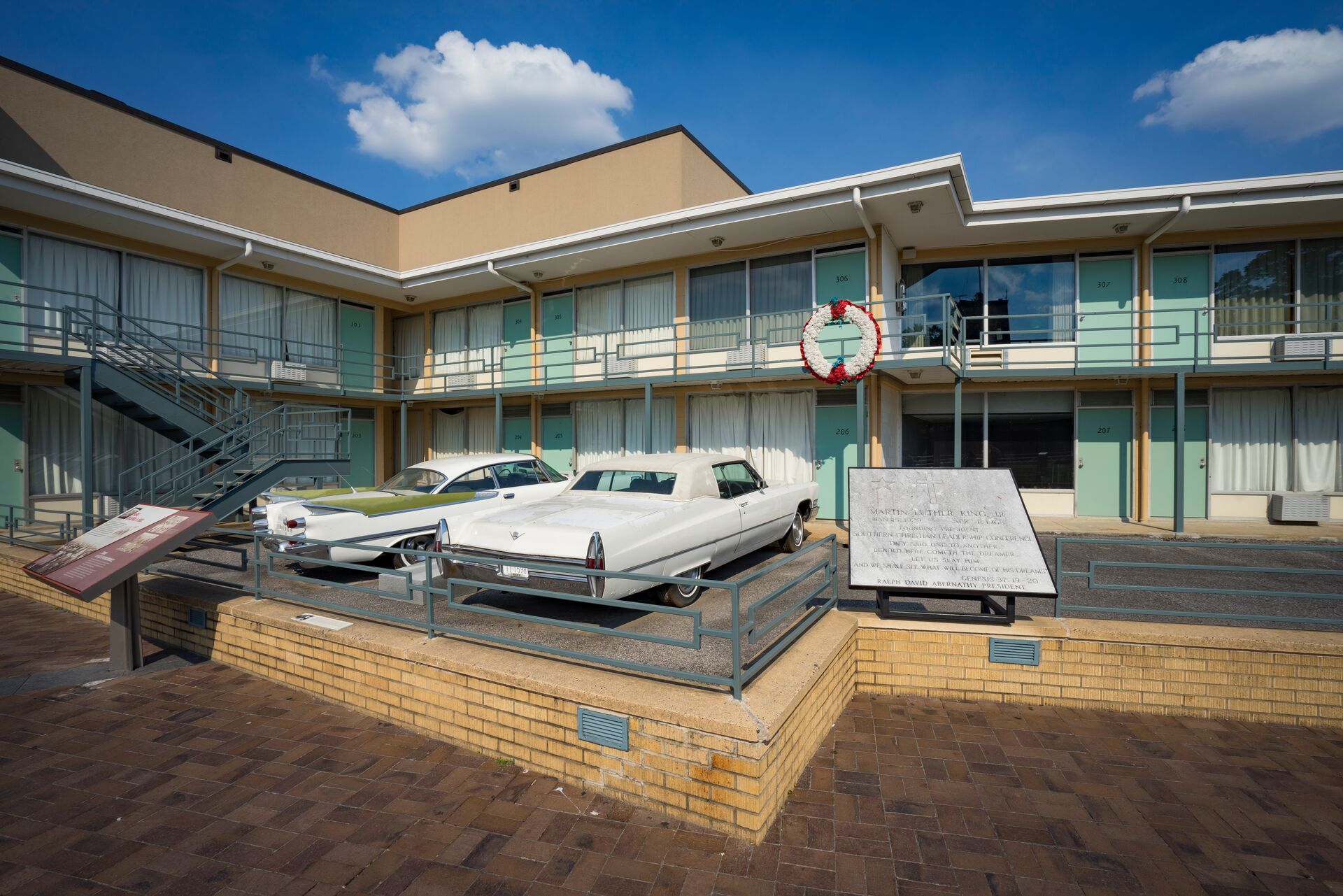
Established in 1991, the National Civil Rights Museum is sited at the former Lorraine Motel, where civil rights leader Martin Luther King Jr. was assassinated on April 4, 1968. The historic motel façade is still intact, and visitors can see Room 306 where Dr. King spent his final hours.
“We wanted to create a space that tells this compelling story, and we wanted it to be at a place of substance and sacredness,” Ryan tells us. “So, the site where Martin Luther King Jr. was assassinated, almost 55 years ago, is a great place for this story to be told. This is living history.”
“We pride ourselves on being the first museum in the United States that chronicles the key events of the American Civil Rights story,” he says. Often the story of the Black freedom struggle is told from the mid 1950s, he explains. “We wanted to tell this story, a story of discrimination, which includes the transatlantic slave trade to America in the 17th century.”
With 260 artifacts, over 40 new films and oral histories, visitors are guided through five centuries of history in a multi-sensory experience. The museum covers slavery, the Civil War and Reconstruction, segregation, and the groundbreaking events of the late 20th century that inspired people around the world to stand up for equality.
“The first two galleries tell a longer story because they cover such a large period of time.” Ryan explains, referring to the exhibits ‘A Culture of Resistance’ and ‘The Rise of Jim Crow’.
“These set the context for what occurs and what is referred to as the modern civil rights movement beginning in 1954.” Subsequent galleries discuss events that took place over a much shorter period, from one or two days, through to one or two years. Click here for a full list of the museum’s exhibits.
Discover this on: Country Roads of the Deep South
“SHOCKING AND SOBERING”
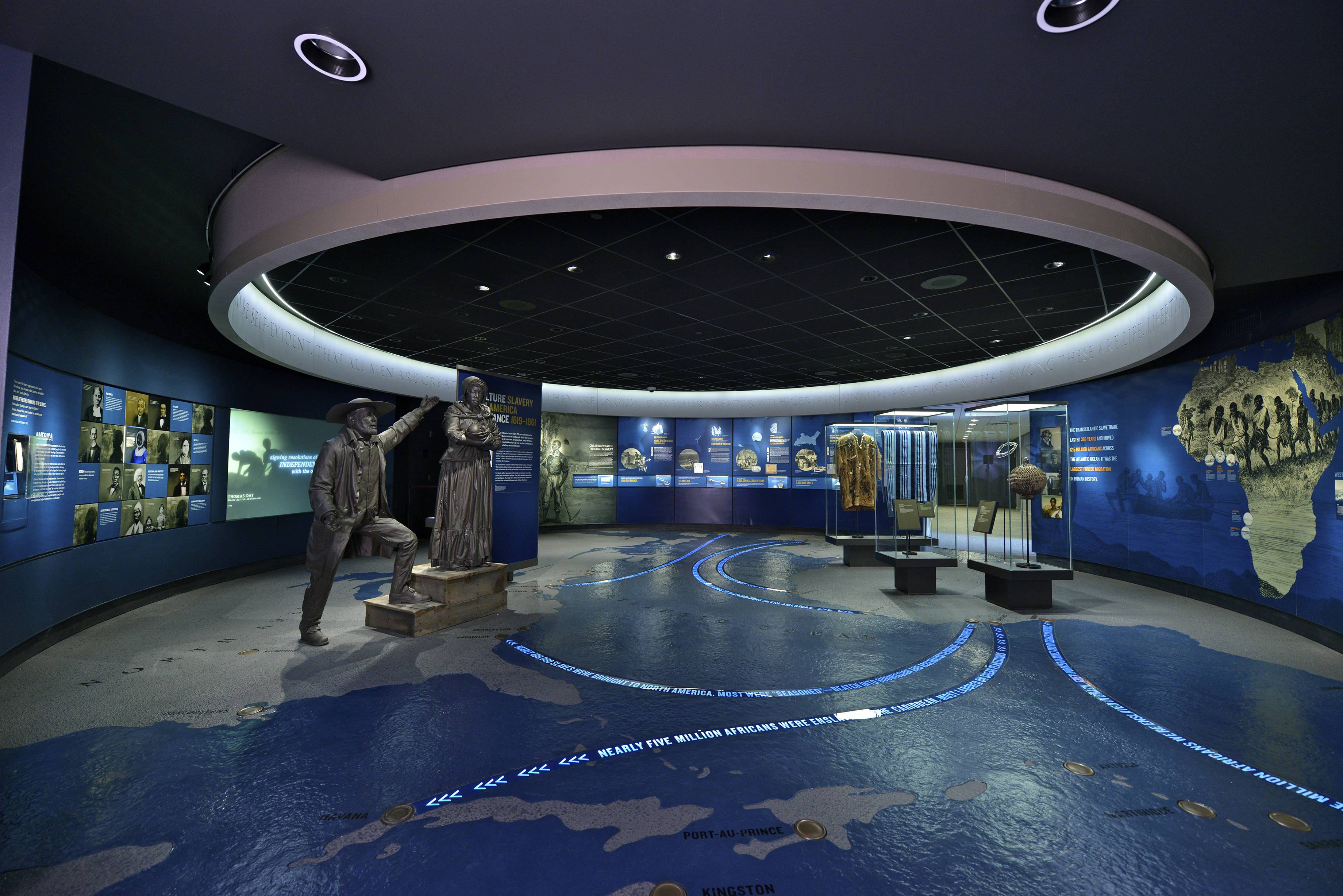
Image courtesy of the National Civil Rights Museum.
The first exhibit, ‘A Culture of Resistance’ offers a graphic representation of the global impact of slavery, covering a period of some 250 years.
“The floor is a globe of the Eastern Western hemisphere,” Ryan shares. “Filled with information and statistics, you can see the key trade routes and how many enslaved Africans were transported across the world. Then, as you look up you see a quote from the preamble of the United States, which says “we hold these truths to be self-evident, that all men are created equal.” You then look at face level and see a sculpture of a woman being auctioned off into bondage in the United States.
“Visually, it’s shocking and sobering. We intended to bring that emotion to life as much as we could,” Ryan says. “Audio plays while you’re witnessing this exhibit. You can hear enslaved Africans who are in disarray, you can hear the sounds of the beatings as you visualize the dehumanizing conditions of the slave ships.”
AN IMMERSIVE HISTORY LESSON
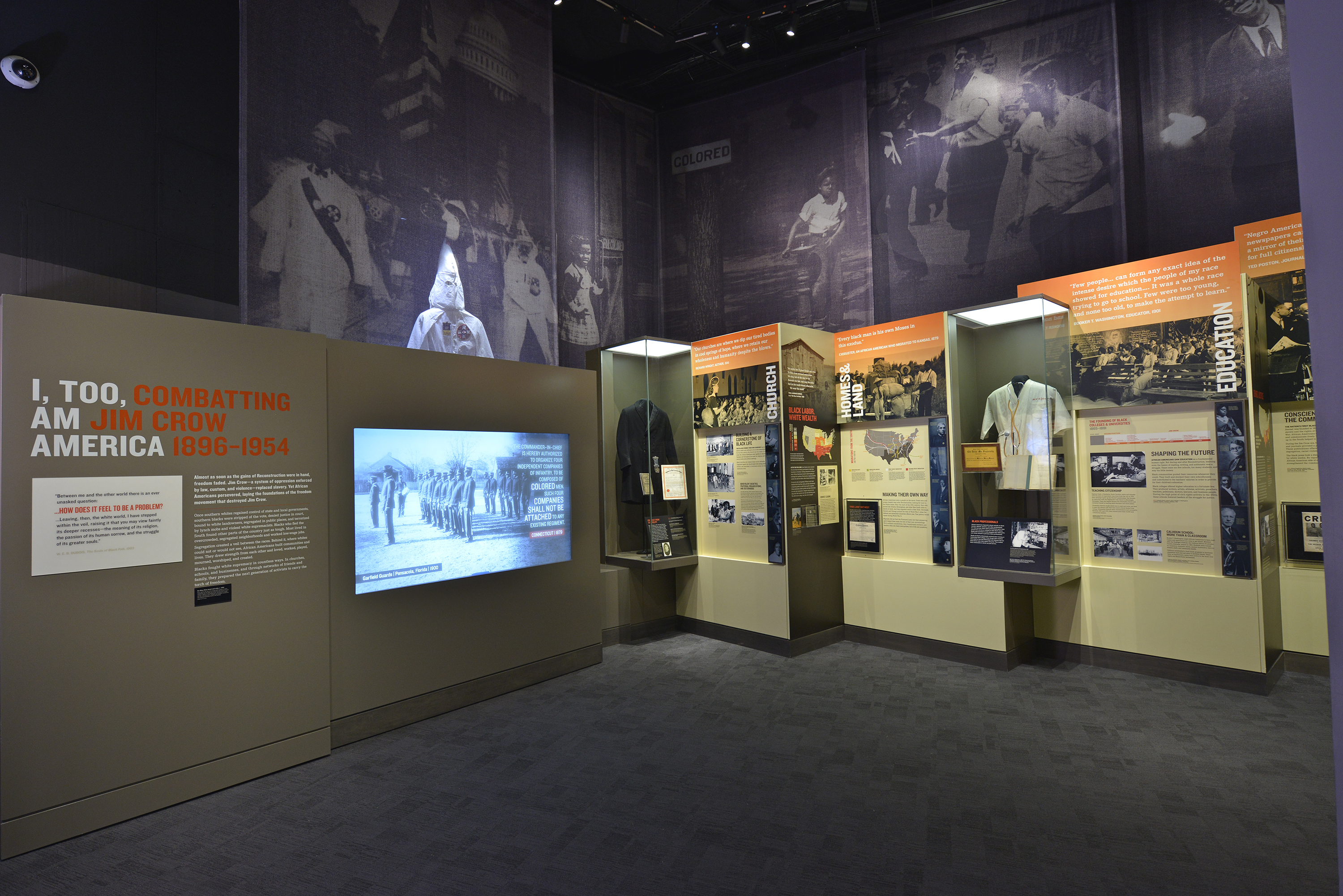
Image courtesy of the National Civil Rights Museum.
“The Rise of Jim Crow” exhibit then offers visitors an immersive history lesson. It walks you through the amendments and legislation that granted rights to African Americans, and the laws and Supreme Court decisions that struck them down, establishing “Separate but Equal” as the law of the land.
“When you walk into the exhibit room, you see public facilities and accommodations that were affected by segregation laws, such as bathrooms, water fountains, schools and restaurants.” Ryan explains. These are set alongside the key themes that come out during this period, including Jump Jim Crow.
“Jump Jim Crow was a minstrel show character used to degrade and humiliate African American life,” Ryan continues. “This led to these newly created segregation laws being referred to as Jim Crow laws, and this entire era spanning from the beginning of the 20th century until the mid 1960s, is referred to as the era of Jim Crow.”
Numerous other themes of this Civil Rights Museum exhibit include the fight for a better education and the role of educators, including Booker T. Washington and W.E.B. Dubois.
“This was also a period of domestic terrorism, with groups like the Ku Klux Klan that are formed to use violence and intimidation to keep African Americans from having first class citizenship rights.” Ryan says. “The exhibit covers the many different barriers that were broken between the First and Second World Wars, and the rise of celebrities and entertainers using their platforms to speak out against the injustice of civil rights.
“This then brings us to a much more itemized study and education of the modern civil rights movement.”
With so much on offer at the National Civil Rights Museum, we asked Ryan about the innovative ways some of these key moments are brought to life for visitors.
THE YEAR THEY WALKED: MONTGOMERY BUS BOYCOTT 1955 – 1956
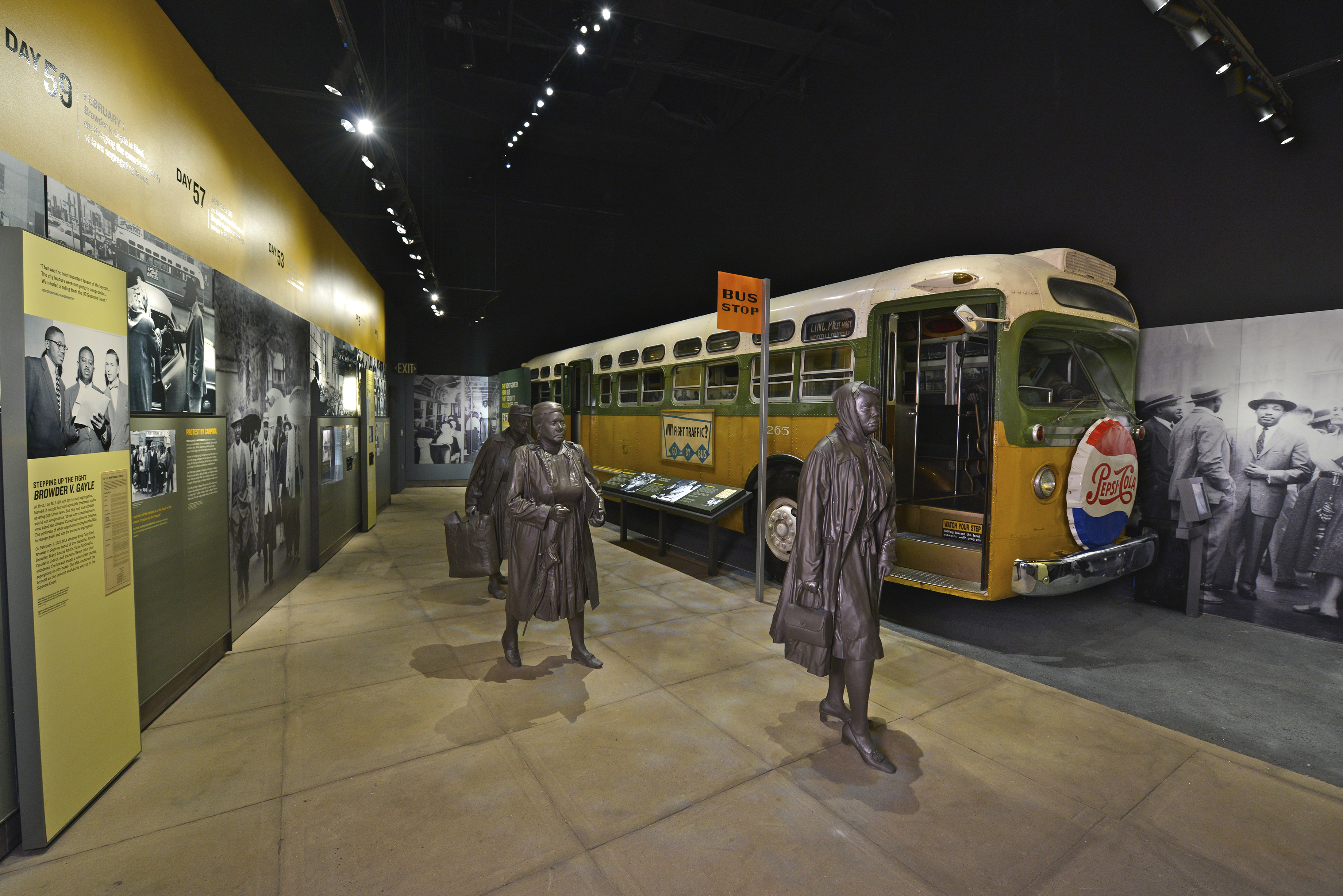
Image courtesy of the National Civil Rights Museum.
Hailed as one of the museum’s most moving and dramatic exhibits, ‘The Year they Walked’ tells the story of Rosa Parks, who refused to give up her seat on a Montgomery, Alabama, city bus for white passengers in 1955, and was arrested for violating the city’s racial segregation ordinances.
“This caused an outrage in the black community in Montgomery because Mrs. Parks was not the first African American woman that year to be arrested,” says Ryan.
The community responded by organizing a remarkable year-long bus boycott, led by local ministers Ralph Abernathy and the newly elected reverend, Martin Luther King, Jr.
“A progressive voice was needed” Ryan tells us. “Someone with new ideas and a new way to look at things. And this is how the 26-year-old pastor, Martin Luther King Jr., comes into this lens of the arena of the civil rights movement.”
“When you go into this gallery, you immediately see mug shots of these African American women,” continues Ryan, who explains that the Montgomery Bus Boycott would not have been successful without their courage and sacrifice. “And you see a bus, the same that was used in the 1955 fleet in Montgomery.”
Visitors can sit next to a sculpture of Rosa Parks on the bus while listening to admonishing audio from the bus driver telling her to give up her seat and move back, or else she will be arrested. “It puts you in the mind where you’re able to sit in this bus to hear that experience, and then through 381 days you are seeing these women walking and refusing to ride the bus,” Ryan says. “Their campaign was successful because this was the first immediate accomplishment and achievement of the civil rights movement.”
COMBINING ARTIFACTS AND REAL TIME FOOTAGE
A renovation of the National Civil Rights Museum in 2014 saw more than 40 new films and oral histories being introduced to the public. This provides increased interactive options for museum goers, bringing to life the story of struggle and the fight for human rights into the 21st century.
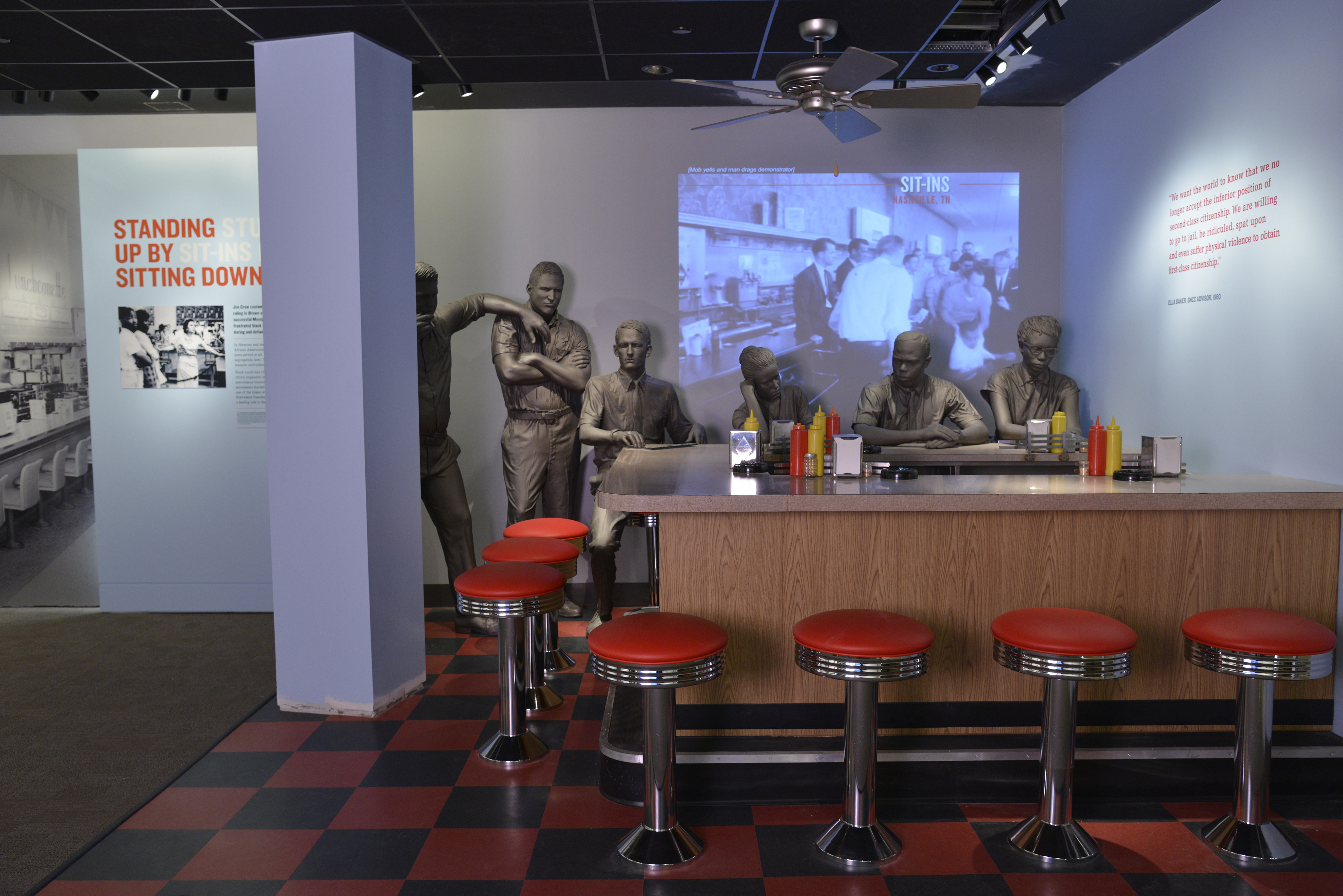
Image courtesy of the National Civil Rights Museum.
The addition of film footage is powerfully used in the exhibit ‘Standing up by Sitting Down: Student sits-ins 1960’. Illustrated with three-dimensional figures at the counter and hecklers by their side, this exhibit is made all the more powerful as you view actual news footage of the demonstrations.
“You’re able to see news footage of student activists that were attacked for wanting to sit down at a lunch counter to be served,” Ryan tells us. “I think that the best way to interpret history is to watch how it happened. Today we use our smartphones to interpret what is going on in the country, but in 1960 for the first time, people who were unaccustomed to seeing what racism was like, turn on their television screens and that’s what they see. They see 17-year old’s who have just completed grade school who realized even at that early age, if I don’t go and fight for my constitutional right, we’re going in the wrong direction.”
LIVING HISTORY
Combining historical audio with the actual setting of events, the final exhibit “King’s Last Hours” offers visitors a truly one-of-a-kind experience.
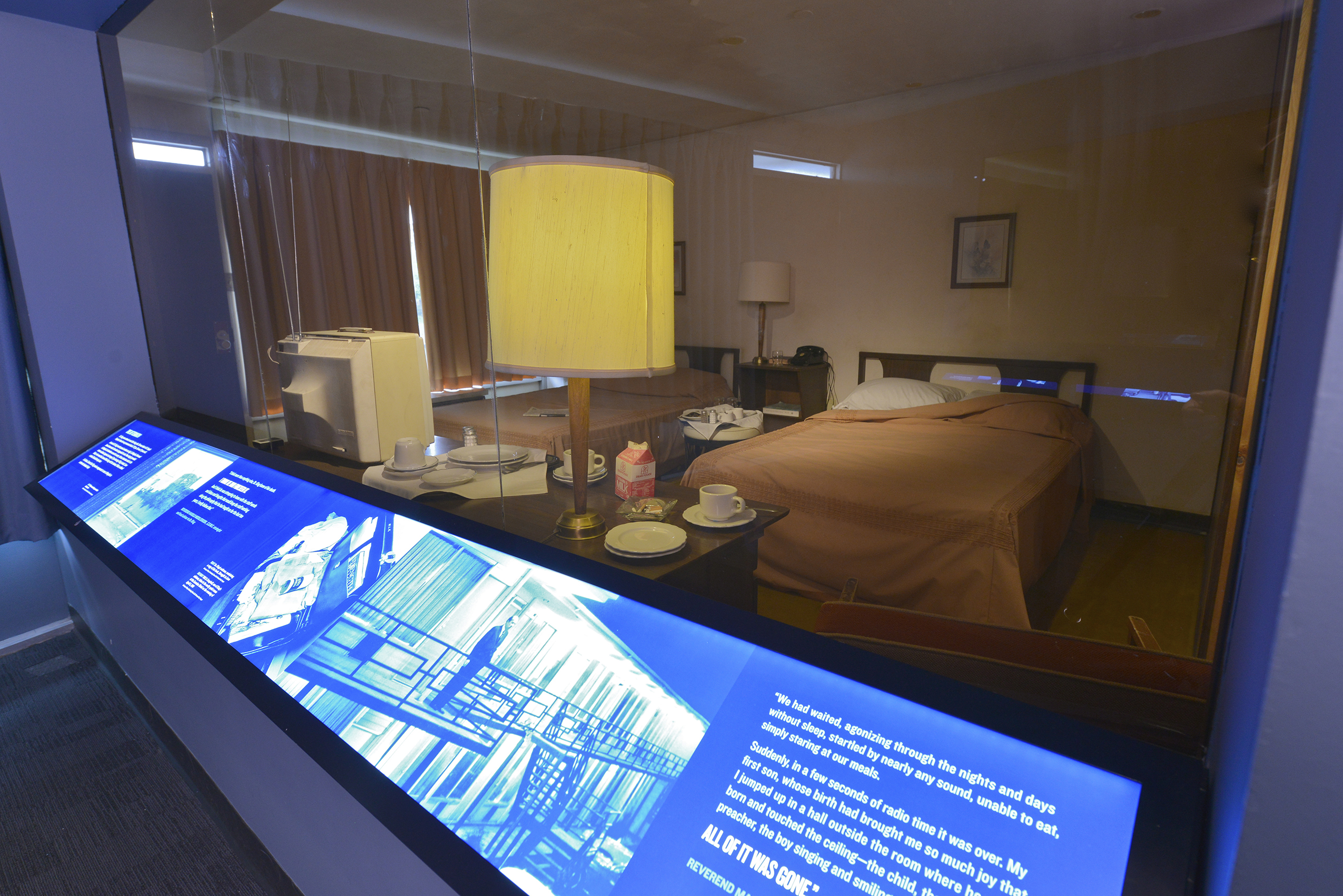
Image courtesy of National Civil Rights Museum
“You hear Martin Luther King Jr. deliver a very eerie prophetic speech the night before he’s killed”, Ryan tells us. “At the conclusion of this speech he says ‘I may not get there with you, but I want you to know tonight that we, as a people, will get to the promised land. So tonight, I’m not worried. I’m not fearing any man. My eyes have seen the glory of the coming of the Lord’.”
Visitors then step into the last two remaining rooms of the Lorraine Motel.
“As you walk, you’ll see room 307, a room that on one previous visit, Martin Luther King Jr. stayed in, but when he returned in April 1968, that room was occupied. And you can see the actual room that he and his associate, the Reverend Ralph Abernathy, stayed in, 306.” Recreated as it looked on that very day, it all matches up with the infamous photograph of Martin Luther King Jr. lying in a pool of blood, and his aides are pointing in the direction they thought the shot came from across Mulberry St.”
THE MODERN CIVIL RIGHTS MOVEMENT
With the current exhibits ending with the events of 1968, we asked Ryan how the National Civil Rights Museum plans to document more recent and continuing events of the civil rights movement.
“In the spring of 2023, we will be beginning the renovation of another building to tell those much more current stories of the social justice movement that has continued to occur in the United States since April 4, 1968,” Ryan says. “Here we will tell a comprehensive story all of events and people that were involved, and also tell the story of the investigation of Doctor King’s death.”
THE CIVIL RIGHTS MOVEMENT TODAY, AND WHAT WE CAN DO
While the civil rights movement has come a long way, we asked Ryan what advice he would give on things we can do every day to make an impact in supporting historically underrepresented communities.
“I would be educated and open minded,” he says. “This was America’s history, and in order to reconcile and move from that, we must acknowledge and understand how it happened. I would take my time to realize that these acts of resistance were very courageous and that this is not ancient history.
“As we’re beginning to see some of the same parallels of that era recycled into our current state of America today, we need to remember and understand why they walked in Montgomery. Or why it’s so important to exercise your civic duty of voting because so many people were murdered for trying to register a vote, a right that should have been given to them at birth. Learning those key stories and realizing how you can apply that type of positive social change to your daily life today, that’s how I would approach that.”
You can visit the National Civil Rights Museum, a MAKE TRAVEL MATTER® Experience on our Country Roads of the Deep South premium guided tour. You can also pay your respects to Dr Martin Luther King Jr. at his memorial statue in Washington D.C., known as the Stone of Hope. To learn more about the civil rights movement, take a look at these helpful information and resources, collated by the National Civil Rights Museum.
Each week, our Insightful Trivia Game will introduce you to the world’s leading destination experts and challenge you with a quiz to win a monthly travel prize.
In commemoration of Dr. Martin Luther King Jr. Day, a federal holiday in the USA, this week’s questions are themed around the USA with a couple dedicated to the Civil Rights Movement, so we hope you’ve been reading closely.
Test your USA destination knowledge and play to win prizes.




